The 100th anniversary of the First World War is now finished but the records will continue to be preserved at the Archives and accessible to current and future generations who want to know more about the time period. In addition, this blog will remain on our website as an additional resource.
February 2018 Posts:
- 26 February: Charles Francis writes to his mother about a surprise visitor and his plans for “apres le guerre”
- 19 February: The HBC and the Creation of Memorial Boulevard
- 12 February: A Valentine from Canada
- 5 February: “Winnipeg Will Suffer Heavily” – Charles A.R. Gordon's 1916 War Diary
26 February 2018
Charles Francis writes to his mother about a surprise visitor and his plans for “apres le guerre”
In our 24 July 2017 post, we wrote about finding a photograph of Herb Francis and mentioned his brother Charles who also served in the First World War. There was another brother, Russell, who served as well (but was not pictured in the photograph featured in the July blog).
Charles, Herbert and Russell all wrote to their mother, Sarah Margaret Francis, throughout their time overseas. The letters are part of the Sarah Margaret Francis fonds held at the Archives and others are in the Charles Ross Francis fonds.
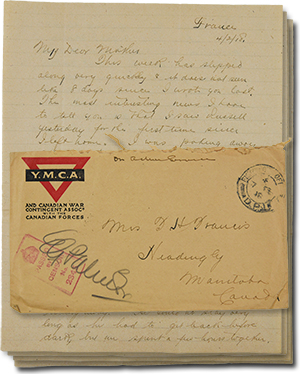
(5 images)
In a letter to his mother, dated 4 February 1918, Charles tells her about a surprise visitor he had the day before. He was working on his typewriter when he felt someone pinch his arm and he looked up and saw his brother Russell for the first time since he left home.
He writes that he was “standing beside me with that old time broad smile on his face”!

He tells his mother that Russell is sunburned which makes his face look ‘wrinkly’ but reassures her that “he looks awfully well though”.

He also writes about their family in England, who all the brothers connected with while training in England and on leave, and about Herb who had been injured and was waiting to be sent home to Canada. Finally, he reflects on his current office job which he prefers to the Battalion, although he does not get enough exercise.
Still, he feels it keeps him in “good turn for office work ‘apres le guerre’ ”, unless he decides to go homesteading on his “ ‘grant”, up near the North Pole somewhere”!

He tells his mother he will raise pigs because they will be worth lots of money when the next war starts.
The First World War letters in the Archives of Manitoba’s holdings give such an interesting glimpse of life at the Front and at home. We encourage you to read the letters we have digitized and put online and/or come to the Archives to see our current display (entitled 1918: Selected records from the last year of the war). You can search for more letters and other First World War-related records in the Archives Research Room and on our Keystone database.
Search Tip: Search “Charles Ross Francis” or “Sarah Margaret Francis” in Keystone for more information about the Francis family and the records at the Archives of Manitoba.
Feedback
E-mail us at [email protected] with a comment about this blog post. Your comments may be included on this page.
19 February 2018
The HBC and the Creation of Memorial Boulevard
As the Manitoba Legislative Building was under construction during the war years, the HBC was making plans to build a new store in downtown Winnipeg. The HBC had operated its Winnipeg store on Main Street since 1881 but, by 1910, the company realized that Portage Avenue had become the heart of retail shopping in Winnipeg.
Planning began for the construction of a modern department store on Portage Avenue between Vaughan and Colony Streets, a site purchased in 1911. However, the building project was delayed. The City of Winnipeg had long been interested in constructing a mall or grand boulevard connecting Portage Avenue to the Legislative Building, but had to clear land ownership hurdles, particularly with the HBC, to make this a reality.
Since these plans involved creating this new boulevard between Vaughan and Colony Streets, the HBC had to give up some of its newly acquired land for road reconfiguration. During the war years, land deals were negotiated and proposed street reconfigurations were debated. The HBC deferred the building of its new flagship store until the city’s plans concerning road access were finalized and final land deals were brokered.
The Legislative Building opened in 1920. By the mid-1920s a land swap deal between the two parties was finally agreed upon. Construction on the new store began September 25, 1925. That same year, the city announced construction of the first phase of “the Mall,” as it was first known, from Portage Avenue to St. Mary Avenue. Since the University of Manitoba still occupied land south of St. Mary, it would take a few more decades before the Mall reached the Legislative Building.
On November 18, 1926, the HBC opened the doors to its new department store. That same year, the Mall was renamed Memorial Boulevard, with the intentions of the new street being not only a grand approach to the Legislative Building, but also becoming a site for monuments dedicated to Winnipeg’s casualties during the First World War.
The creation of Memorial Boulevard is remembered with an engraving on the northwest corner of the HBC store on the outside wall. It reads:
“Memorial Boulevard, named in commemoration of the citizens of Winnipeg, men and women who gave their lives in the Great War, 1914-1918.”
The Hudson’s Bay Company Archives has records that deal with these land negotiations, including a number of plans of proposed road revamping for the creation of Memorial Boulevard.
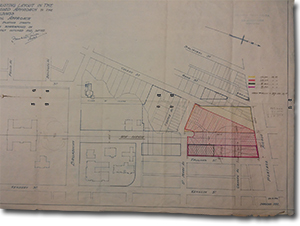
The plan featured here was created by architect Frank Worthington Simon in 1918. It originally accompanied correspondence kept by the HBC’s Canadian Committee regarding the creation of Memorial Boulevard. The original plan shows the existing street layout at 1918, with Simon’s proposed alterations superimposed with bolder lines. The coloured pencil annotations were added by the HBC, showing square footages of sections of their property.
Search Tip: Search “Memorial Boulevard” in Keystone for more information. Search “Frank Simon” and “Provincial Architect” for more records of Simon’s work.
Feedback
E-mail us at [email protected] with a comment about this blog post. Your comments may be included on this page.
12 February 2018
A valentine from Canada
Jessie Ambrose was born Jessie Paul in England in 1897. Her father died when she was very young and her mother married a man named Francis Rose, and had two more children, Cecilia and William. When Jessie’s mother, stepfather and siblings immigrated to Canada in 1906, Jessie remained in England with her aunt and uncle Ambrose in Catford, Kent.
Her mother wrote letters to Jessie from the various places that Mr. Rose’s job as a railway freight agent took the family. In 1918 they were living at 338 8th Street in Brandon, Manitoba.
In a letter dated 10 February 1918, Jessie’s mother enclosed a Valentine:
“There is a Valentine put in this letter what somebody made you have got to guess who sent it just for the fun of it they keep bothering me so there it is.”

The valentine may have been made by Jessie’s younger sister, Cecilia. Jessie’s mother goes on to talk about the weather and the war:
“I shall be glad when we have some warmer weather my Coal Bill is awful we must have warmth if we go short on food in regards of saving it on account of the war we can’t get white flour now. Do you know whether your Aunt Eliza is still at Walworth House. Is Uncle Ernest and his family is there any of them old enough to go to the war. I almost forgot them, don’t think I should know them if I saw them.”
The Jessie Ambrose fonds consists of letters sent to Jessie Ambrose from 1908-1941 not only by her family in Canada but also by friends and relatives in England. The latter provide a glimpse into Jessie’s life in England, in contrast to her mother’s letters, which outline the experiences and hardships of an immigrant family.
Search Tip: Search “Jessie Ambrose” in Keystone for more information about Jessie and her family and the records at the Archives of Manitoba.
Feedback
E-mail us at [email protected] with a comment about this blog post. Your comments may be included on this page.
5 February 2018
“Winnipeg Will Suffer Heavily” – Charles A.R. Gordon's 1916 War Diary
Charles Athol Robertson Gordon was born in Wingham, Ontario on June 11, 1897. He moved to Winnipeg at a young age and joined the army during the First World War. Serving first with the 61st Battalion of the Canadian Expeditionary Force and then with the 12th Field Ambulance Army Medical Corps, Gordon documented his experiences in his 1916 war diary.
After spending time in England, his unit was transferred to the Ypres Salient. In a lengthy entry on August 29, 1916, Gordon described the events of the last few days. During the night, there was a gas attack in his area:

Charles Gordon Diary 1916, August 29, 1916, P8039/2.
Gas alarm sounds! I go down and warn O.C. and go for my helmet – of course I can’t find it. I go to the stores and seize one and put it on, warning the boys sleeping there. I go into the street now rapidly filling with helmeted figures peering at one another and listening to the sound of the sirens of Ypres. … My helmet seems stuffy and in an unguarded moment I breathe through my nose – at once the googles are dimmed and I take a chance and go inside, take off the helmet and wipe them. Putting it on again, I go outside. Here we are all ready but my mind dwells on the poor fellows up in the front line who have but a few minutes warning. How are they faring?
Gordon’s area was safe from gas but in a later part of the entry, he documents the treatment of a wounded soldier and the anger he felt towards the Germans:
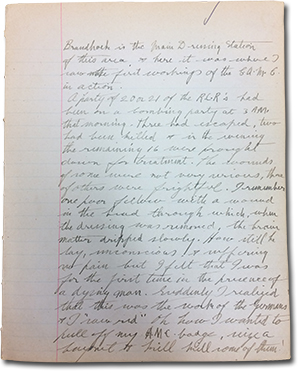
Charles Gordon Diary 1916, August 29, 1916, P8039/2.
I remember one poor fellow with a wound in the head through which, when dressing was removed, the brain matter dripped slowly. How still he lay, unconscious and suffering no pain but I felt that I was for the first time in the presence of a dying man. Suddenly I realized that this was the work of the Germans. [illegible] oh how I wanted to pull off my A.M.C. badge, seize a bayonet and kill kill some of them!
In October, his unit was transferred to the Battle of the Somme. In his entry for Friday, October 13th, he described his first night at the battlefield:
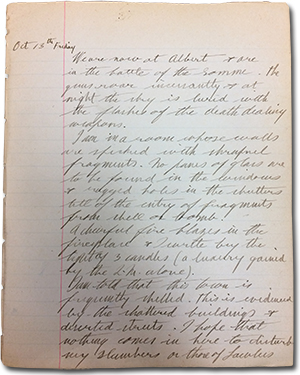
Charles Gordon Diary 1916, October 13, 1916, P8039/2.
We are now at Albert and in the Battle of the Somme. The guns roar incessantly and at night the sky is lurid with the flashes of the death dealing weapons.
There are several entries detailing his experiences treating wounded soldiers, witnessing the last moments of dying men, the mud of the battlefield, aerial dogfights, and passing through ruined villages. Gordon’s unit suffered several casualties during the battle, as this entry from October 23rd illustrates:
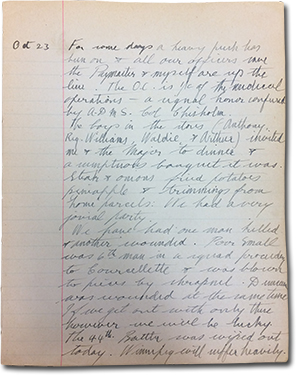
Charles Gordon Diary 1916, October 23, 1916, P8039/2.
We have had one man killed and another wounded. Poor Small was 6th man in a squad proceeding to Courcellette and was blown to pieces by shrapnel. Duncan was wounded at the same time. If we get out with only these, however, we will be lucky. The 44th Battalion was wiped out today. Winnipeg will suffer heavily.
Gordon survived the First World War and was demobilized with the rank of captain. He returned to Winnipeg and enrolled in medical school. After graduating in 1925, he practiced medicine in Winnipeg until the Second World War, where he served with the rank of Lieutenant Colonel and then as the Medical Historian for the Royal Canadian Army Medical Corps. After the war, he continued practicing medicine in Winnipeg until his death in 1977.
As the above entries demonstrate, Gordon’s diary provides vivid descriptions of the life of frontline medical personnel in the First World War. His diary and other records were just recently acquired by the Archives of Manitoba in 2017 and have proven to be valuable additions to our collection.
Search Tip: Search Charles Gordon in Keystone for a full description of this fonds and other records part of this donation.
Feedback
E-mail us at [email protected] with a comment about this blog post. Your comments may be included on this page.



